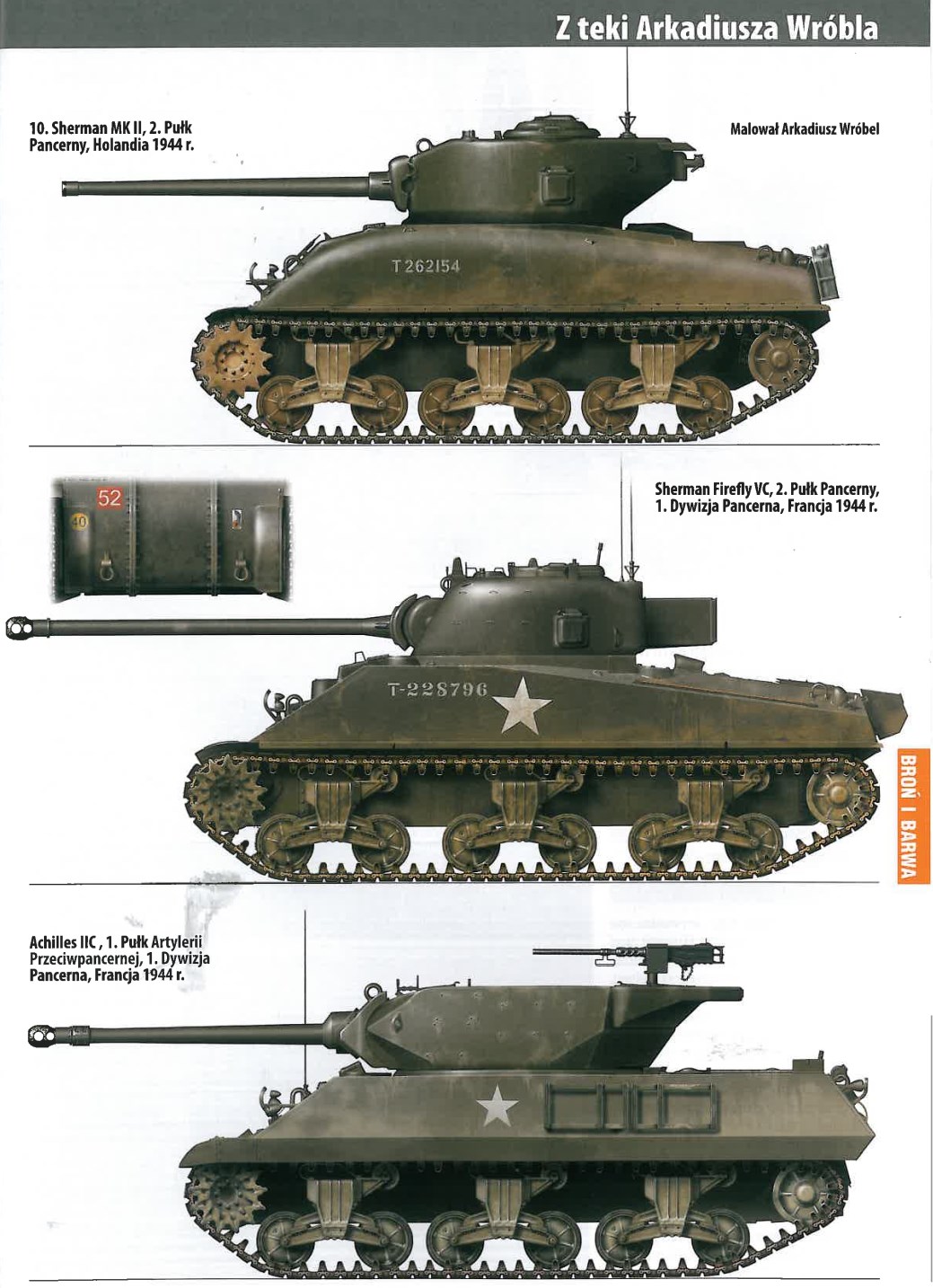
Belgium and the
Netherlands
After the Allied armies broke out from Normandy, the Polish
1st Armoured Division pursued the Germans along the coast of the English
Channel. It liberated, among others, the towns of Saint-Omer, Ypres, Ghent and
Passchendaele. A successful outflanking manoeuvre planned and performed by
General Maczek allowed the liberation of the city of Breda without any civilian
casualties (October 29, 1944). The Division spent the winter of 1944-1945 on
the south bank of the river Rhine, guarding a sector around Moerdijk,
Netherlands. In early 1945 it was transferred to the province of Overijssel and
started to push along with the Allies along the Dutch-German border, liberating
the eastern parts of the provinces of Drenthe and Groningen with towns such as
Emmen, Coevorden and Stadskanaal.
Germany
In April 1945 the 1st Armoured entered Germany in the area
of Emsland. On May 6 the division seized the Kriegsmarine naval base in
Wilhelmshaven, where General Maczek accepted the capitulation of the fortress,
naval base, East Frisian Fleet and more than 10 infantry divisions. There the
Division ended the war and was joined by the Polish 1st Independent Parachute
Brigade. It undertook occupation duties until 1947, when the division was
disbanded, it and the many Polish displaced persons in the Western occupied
territories forming a Polish enclave at Haren in Germany which was for a while
known as “Maczków”. The majority of its soldiers opted not to return
to now Soviet occupied Poland and stayed in exile.
Wilhemshaven 1945
The Germans resisted the Allies strongly on their own
territory but slowly and surely the Allies advanced, and the Polish objective
was altered to the important German naval base at Wilhelmshaven. From 19 to 29
April, the Poles fought hard to advance, as the terrain proved ideal for
defence since it was extremely marshy with a thin layer of peat covering the
tracks along which the tanks and armoured vehicles had to pass. The obvious
routes that the Poles had to advance along meant that the Germans knew
precisely where to place their defences.
The Germans were collapsing on all fronts and Hitler
committed suicide in his bunker in Berlin on 30 April. On 6 May, Maczek
attended a meeting between General Simonds and a German delegation led by
General Erich von Straube. Simonds made it clear that only unconditional
surrender was on offer. The 1st Polish Armoured Division was given the honour
of occupying Wilhemshaven, and Colonel Antoni Grudzinski, second in command of
the Polish 10th Armoured Brigade, noted the reaction of the Germans to this
news:
An officer on my
staff, a former student at Gdansk Polytechnic, translated every sentence into
German. When the words ‘Polish Division’ were uttered by the translator, and as
if by inattentiveness repeated, it seemed the Germans whitened and unease
flashed in their eyes. I enquired if they understood – ‘Jawohl’ – they replied.
I gave a sign that they might leave. But, a thought passed through my mind, ‘This
is for September 1939’.
The Poles took control of Wilhelmshaven and accepted the
surrender of 19,000 German officers, including a general and an admiral. Three
cruisers, 18 submarines, 205 battleships and support vessels plus a vast array
of artillery and infantry weaponry were taken into Polish custodianship. The
division had lost 304 officers and 5,000 other ranks since August 1944. Despite
all that Poland had suffered at the hands of the Germans, Maczek maintained
strict discipline to ensure that the Poles did not take reprisals. This,
despite the fact that the division had liberated a concentration camp at Oberlangen
full of emaciated women POWs, members of the AK who had surrendered after the
collapse of the Warsaw Uprising and had been held there without the protection
of the Geneva Convention. On 19 May, General Anders visited Wilhelmshaven and
Maczek had prepared for the visit by ordering the German population to sew
Polish flags using white sheets and the red portion of the Nazi flags. The
result was an impressive array of Polish flags on 25-feet-high posts shimmering
along the avenue where the division marched past Anders.
Organization during
1944-45
10th Armoured Cavalry Brigade (10 Brygada Kawalerii
Pancernej) – Col. T. Majewski
1st Polish
Armoured Regiment (1 pułk pancerny) – Lt.Col. Aleksander Stefanowicz
2nd Polish
Armoured Regiment (2 pułk pancerny) – Lt.Col. S. Koszustki
24th Polish
Lancers Regiment (Armoured; 24 pułk ułanów im. Hetmana Żółkiewskiego) – Lt.Col.
J. Kański
10th Polish
Dragoons Regiment (10 pułk dragonów zmotoryzowanych) – Lt.Col. Władysław
Zgorzelski
3rd Polish Infantry Brigade (3 Brygada Strzelców) – Col.
Marian Wieroński
1st Polish
Highland Battalion (1 battalion Strzelców Podhalańskich) – Lt.Col. K. Complak
8th Polish Rifle
Battalion (8 battalion strzelców) – Lt.Col. Aleksander Nowaczyński
9th Polish Rifle
Battalion (9 battalion strzelców flandryjskich) – Lt.Col. Zygmunt Szydłowski
1st Polish
Independent HMG Squadron (samodzielna kompania ckm.) – Maj. M. Kochanowski
Divisional Artillery (Artyleria dywizyjna) – Col. B. Noel
1st Polish
Motorized Artillery Regiment (1 pułk artylerii motorowej) – Lt.Col. J.
Krautwald
2nd Polish
Motorized Artillery Regiment (2 pułk artylerii motorowej) – Lt.Col. K. Meresch
1st Polish
Anti-Tank Regiment (formed in 1945 from smaller units) (1 pułk artylerii
przeciwpancernej) – Major R. Dowbór
1st Polish Light
Anti-Aircraft Regiment (1 pułk artylerii przeciwlotniczej) – Lt.Col. O. Eminowicz,
later Maj. W. Berendt
Other Units
10th Polish
Mounted Rifle Regiment (10 pułk strzelców konnych) (amoured reconnaissance
equipped with Cromwell tanks) – Maj. J. Maciejowski
HQ, Military
Police,
engineers (saperzy
dywizyjni) – Lt.Col. J. Dorantt
signals (1
batalion łączności) – Lt.Col. J. Grajkowski
administration,
military court, chaplaincy, reserve squadrons, medical services.
Strength
885 – officers and
NCOs
15,210 – soldiers
381 – tanks
(mostly M4 Shermans)
473 – artillery
pieces (mostly motorized)
4,050 – motor
cars, trucks, utility vehicles, artillery carriers.